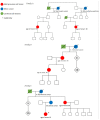Familial Occurrence of Adult Granulosa Cell Tumors: Analysis of Whole-Genome Germline Variants
- PMID: 34069790
- PMCID: PMC8157239
- DOI: 10.3390/cancers13102430
Familial Occurrence of Adult Granulosa Cell Tumors: Analysis of Whole-Genome Germline Variants
Abstract
Adult granulosa cell tumor (AGCT) is a rare ovarian cancer subtype, with a peak incidence around 50-55 years. Although AGCT can occur in specific syndromes, a genetic predisposition for AGCT has not been identified. The aim of this study is to identify a genetic variant in families with AGCT patients, potentially contributing to tumor evolution. We identified four families, each including two women diagnosed with AGCT. Whole-genome sequencing was performed to identify overlapping germline variants or affected genes. Familial relationship was evaluated using genealogy and genomic analyses. Patient characteristics, medical (family) history, and pedigrees were collected. Findings were compared to a reference group of 33 unrelated AGCT patients. Mean age at diagnosis was 38 years (range from 17 to 60) versus 51 years in the reference group, and seven of eight patients were premenopausal. In two families, three first degree relatives were diagnosed with breast cancer. Furthermore, polycystic ovary syndrome (PCOS) and subfertility was reported in three families. Predicted deleterious variants in PIK3C2G, BMP5, and LRP2 were identified. In conclusion, AGCTs occur in families and could potentially be hereditary. In these families, the age of AGCT diagnosis is lower and cases of breast cancer, PCOS, and subfertility are present. We could not identify an overlapping genetic variant or affected locus that may explain a genetic predisposition for AGCT.
Keywords: FOXL2; granulosa cell tumor; ovarian cancer; sex cord-stromal tumors; whole-genome sequencing.
Conflict of interest statement
The authors declare no conflict of interest.
Figures



Similar articles
-
Ovarian Adult Granulosa Cell Tumors: A Scoping Review of DNA Alterations and Their Known Significance.Anticancer Res. 2025 Jan;45(1):1-10. doi: 10.21873/anticanres.17388. Anticancer Res. 2025. PMID: 39740818
-
Genomic profiling of primary and recurrent adult granulosa cell tumors of the ovary.Mod Pathol. 2020 Aug;33(8):1606-1617. doi: 10.1038/s41379-020-0514-3. Epub 2020 Mar 12. Mod Pathol. 2020. PMID: 32203090 Free PMC article.
-
Whole Genome Analysis of Ovarian Granulosa Cell Tumors Reveals Tumor Heterogeneity and a High-Grade TP53-Specific Subgroup.Cancers (Basel). 2020 May 21;12(5):1308. doi: 10.3390/cancers12051308. Cancers (Basel). 2020. PMID: 32455687 Free PMC article.
-
Prophylactic Oophorectomy: Reducing the U.S. Death Rate from Epithelial Ovarian Cancer. A Continuing Debate.Oncologist. 1996;1(5):326-330. Oncologist. 1996. PMID: 10388011
-
The FOXL2 mutation (c.402C>G) in adult-type ovarian granulosa cell tumors of three Japanese patients: clinical report and review of the literature.Tohoku J Exp Med. 2013 Dec;231(4):243-50. doi: 10.1620/tjem.231.243. Tohoku J Exp Med. 2013. PMID: 24257635 Review.
Cited by
-
Single-cell profiling of the human endometrium in polycystic ovary syndrome.Nat Med. 2025 Jun;31(6):1925-1938. doi: 10.1038/s41591-025-03592-z. Epub 2025 Mar 20. Nat Med. 2025. PMID: 40114027 Free PMC article.
-
DNA alterations in ovarian adult granulosa cell tumours: A scoping review protocol.PLoS One. 2024 Jun 14;19(6):e0303989. doi: 10.1371/journal.pone.0303989. eCollection 2024. PLoS One. 2024. PMID: 38875223 Free PMC article.
References
Grants and funding
LinkOut - more resources
Full Text Sources

